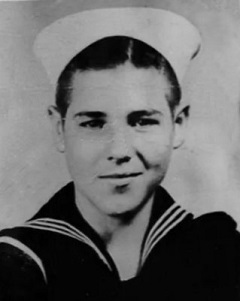GRAHAM-CALVIN
CALVIN LEON GRAHAM

S1 / CPL

YOUNGEST MAN TO SERVE IN NAVY DURING WORLD WAR II
The youngest man to serve in the U.S. Navy during World War II was reported to be Calvin Leon Graham who was only 12-years old when he lied about his age and enlisted in the Navy in May 1942. He was the youngest of six children in a farm family and grew up in Crockett, Texas. To escape from an abusive stepfather, Graham and an older brother moved into a cheap rooming house where Calvin supported himself by selling newspapers and delivering telegrams. His mother would occasionally visit, sometimes to simply sign his report cards at the end of a semester. With the country at war Graham began to think about joining the military and began to shave at age 11, hoping it would make him look older to recruiters. At 5-foot-2 and just 125 pounds Graham practiced “talking deep.” Dressed in an older brother’s clothes he quit school in the seventh grade, told his mother he was going away to visit relatives but instead persuaded Navy recruiters he was 17 years of age using forged documents that he and his friends had produced.
Following recruit training at San Diego he was assigned as a gunner to the USS SOUTH DAKOTA (BB-57). During the night of November 14-15, 1942, SOUTH DAKOTA engaged in intense action off Guadalcanal against a Japanese fleet and received at least 26 hits during the battle which caused extensive damage and started numerous fires. During the battle Graham was manning his gun when shrapnel tore through his jaw and mouth, another hit knocked him down and he fell through three decks of superstructure. Although seriously wounded he helped pull other crew members to safety and assisted in fire fighting damage control. Graham later recalled, “I took belts off the dead and made tourniquets for the living. It was a long night. It aged me.” The shrapnel had knocked out his front teeth and he had flash burns but he was “fixed up with salve and a couple stiches,” he recalled. “I didn’t do any complaining because so many were dead.” For his efforts Graham was awarded the Bronze Star for his bravery and the Purple Heart for his injuries. When Graham’s mother later recognized Graham in newsreel footage she wrote the Navy, revealing his true age. The Navy responded by placing Graham in the brig at Corpus Christi, Texas, for lying about his age. He was confined for about three months and only released when the Navy learned that Graham’s sister was threatening to contact newspapers concerning the Navy’s treatment of her brother who writers were referring to as the “Baby Vet.” In May 1943, Graham was given a Dishonorable Discharge from the Navy, thereby stripping him of his medals and losing his disability benefits.
Back in Houston he was treated as a celebrity for a short time but the attention quickly faded. At age 13 he tried to return to school but couldn’t keep pace with students his age and quickly dropped out. He married at age 14, became a father the following year and found work as a welder in a Houston shipyard. At 17-years old he was about to be drafted when he enlisted in the U.S. Marine Corps in 1948. He achieved the rank of Corporal before falling from a pier and breaking his back which ended his military career in 1951. Although serving in the Marines qualified him as a veteran, Graham spent the rest of his life struggling to get the decorations and medical benefits back, and to get a retroactive Honorable Discharge. In a 1978 interview Graham said the discharge program for Vietnam War deserters at last gave him a hope of getting his discharge as he was “Damn sure deserved more than a deserter did.” In 1978 he was finally awarded an Honorable Discharge, and after writing to Congress and with the help of two Texas Senators and approval of President Carter, all medals except his Purple Heart were reinstated. His story came to public attention in 1988 when his story was told in the TV movie, “Too Young the Hero.” In 1988 President Reagan signed legislation that granted Graham full disability benefits, increased his back pay to $4,917 and allowed him $18,000 for past medical bills. However, by this time some of the doctors who had treated him had died and many medical bills had been lost. He received only $2,100 of the possible $18,000. While the money for the rights to his story for the movie amounted to $50,000, 50% went to two agents and 20% went to a writer of an unpublished book about Graham. Thus, Graham and his wife only received $15,000 before taxes.
Graham died on November 6, 1992, from heart failure and was buried at Laurel Land Memorial Park in Fort Worth, Texas. Finally, in 1994 after intervention by Presidents Carter and Clinton, Graham’s Purple Heart was finally reinstated and presented to his widow.
Submitted by CDR Roy A. Mosteller, USNR (Ret)

